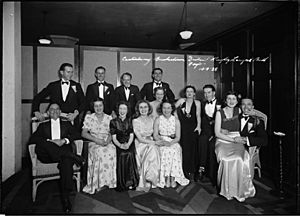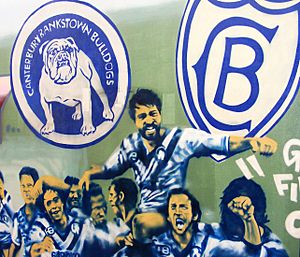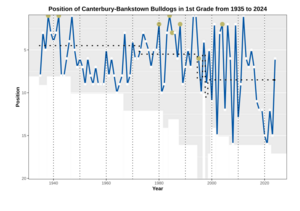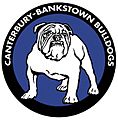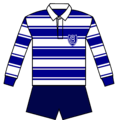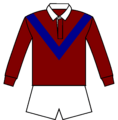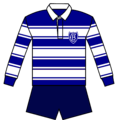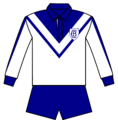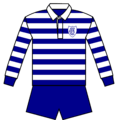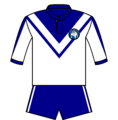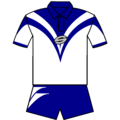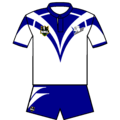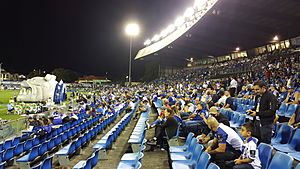Canterbury-Bankstown Bulldogs facts for kids
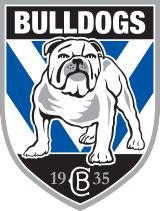 |
|||
| Club information | |||
|---|---|---|---|
| Full name | Canterbury Bankstown Bulldogs Rugby League Club Limited | ||
| Nickname(s) | Berries, Blue and Whites, Dogs, Doggies, Dogs of War, The Family Club, The Entertainers | ||
| Website | bulldogs.com.au | ||
| Colours | Blue White |
||
| Founded | 1935 | ||
| Current details | |||
| Ground(s) |
|
||
| CEO | Aaron Warburton | ||
| Chairman | Adam Driussi | ||
| Coach | Cameron Ciraldo | ||
| Manager | Phil Gould | ||
| Captain | Stephen Crichton | ||
| Competition | National Rugby League | ||
| 2024 Season | 6th | ||
| Uniforms | |||
|
|||
| Records | |||
| Premierships | 8 (1938, 1942, 1980, 1984, 1985, 1988, 1995, 2004) | ||
| Runners-up | 10 (1940, 1947, 1967, 1974, 1979, 1986, 1994, 1998, 2012, 2014) | ||
| Minor premiership | 8 (1938, 1942, 1947, 1984, 1993, 1994, 2012) | ||
| Wooden spoons | 6 (1943, 1944, 1964, 2002, 2008, 2021) | ||
| Most capped | 317 - Hazem El Masri | ||
| Highest points scorer | 2418 - Hazem El Masri | ||
The Canterbury-Bankstown Bulldogs are a professional rugby league team from Australia. They are based in Belmore, a suburb in the Canterbury-Bankstown area of Sydney. The team plays in the top-level NRL Telstra Premiership. They also have teams in other competitions run by the New South Wales Rugby League, like the NSW Cup and junior leagues.
The club joined the New South Wales Rugby Football League premiership in 1935. This league was the one before the current NRL. They won their first championship in their fourth year, and another one soon after. After a quieter period in the 1950s and 1960s, they became very strong in the 1980s, winning four championships.
The Bulldogs won the first national championship in 1995. They then joined a different league called Super League in 1997 during the "Super League war." They returned in 1998 for the first NRL season and have played there ever since.
In 1995, they were known as the Sydney Bulldogs. They changed back to Canterbury-Bankstown Bulldogs until 1999. Then they were just called The Bulldogs without a specific place name. In 2009, they returned to their current name. The club has won 8 championships, with their most recent in 2004. In 2012, they won their most recent minor premiership (finishing first in the regular season). Their last Grand Final appearance was in 2014, where they lost to the South Sydney Rabbitohs. People often call them Canterbury, the Bulldogs, or just the Dogs.
Contents
Club History
The Canterbury club joined the top New South Wales Rugby Football League premiership in 1935. This was 13 years after the Canterbury-Bankstown Junior Rugby League started. The new club was sometimes called "Country Bumpkins" because they recruited players from rural areas. They won their first championship in 1938, just four years after joining. They won again in 1942. After that, they had a long wait of 38 years before winning another championship.
In 1967, the team, then known as "The Berries," beat St. George in the final. This ended St. George's 11-year winning streak. However, Canterbury lost to South Sydney in the Grand Final that year. This strong performance helped the club make changes off the field, which set them up for future success.
In 1978, Canterbury became known as "The Bulldogs." Older nicknames like "Cantabs" and "Berries" seemed too soft. The club wanted a name that showed determination and toughness. They bought the new name and logo from a local store owner. They reached the Grand Final in 1979. Then, in 1980, they won the Grand Final with a young, exciting team called "The Entertainers." This started a golden age, with three more Grand Final wins in the 1980s: 1984, 1985, and 1988.
During the "Super League war" in the mid-1990s, Canterbury joined the Super League competition. They played in the 1997 premiership season. In 1998, the Bulldogs almost won another championship. They made it to the Grand Final but lost to the Brisbane Broncos 38–12. On their way to the 1998 Grand Final, Canterbury had two amazing comeback wins. One was against the Newcastle Knights, where they came back from 16–0 down to win in extra time. A week later, they were 16 points behind their rivals, Parramatta, with only 9 minutes left. They scored three tries and a sideline conversion to tie the game. Canterbury then won 32–20 in extra time, in one of the greatest comebacks in finals history.
After some mixed results from 1999 to 2001, the club faced a big problem in 2002. They were found to have broken the NRL's salary cap rules in 2001 and 2002. As a punishment, they lost all 37 competition points they had earned in 2002. This made them drop from first place to last, and they received their first "wooden spoon" (given to the team that finishes last) since 1964.
The Bulldogs bounced back in 2003. They almost reached the Grand Final again but lost to the Roosters 28–18 in the preliminary final.
In 2004, the club had some serious issues off the field. Despite these challenges, the team focused on their games. They won the championship by beating the Sydney Roosters 16–13 in the 2004 Grand Final. A try-saving tackle by Andrew Ryan in the final seconds secured the win. This was the last game for captain Steve Price, though he missed it due to injury. Price later returned to the club as the General Manager of Football in 2020.
In 2005, Canterbury struggled with injuries and player contract talks. They couldn't defend their championship title and missed the finals. In 2006, not much was expected from them, but their strong forward players helped them do better. They reached one game short of the Grand Final, losing to the Brisbane Broncos. In 2007, inconsistent play meant they were knocked out of the finals early.
In 2008, key players like Mark O'Meley and Willie Mason left the club. Later, halfback Brent Sherwin also departed. The team faced many injuries, and when Sonny Bill Williams left mid-season, it affected the club's morale. Canterbury finished last, earning their second wooden spoon of the decade.
There were also changes in the club's leadership in 2008. New members were elected to the board, and CEO Malcolm Noad resigned. Todd Greenberg took over as the head of the football club.
Greenberg's impact was clear in the 2009 season. Steve Folkes, a championship-winning coach, was replaced by his assistant Kevin Moore. The club signed important players like Brett Kimmorley. Canterbury went from struggling to being one of the best clubs on and off the field. They finished second in the regular season. Many players and officials won Dally M awards. 2009 was also the last season for Hazem El Masri, who became the highest all-time point scorer in Australian rugby league history.
From 2010, Canterbury returned to the name Canterbury-Bankstown Bulldogs. The club celebrated its 75th anniversary in 2010.
In the 2012 NRL season, Canterbury finished first in the league, winning their first minor premiership since 1994. They reached the Grand Final but lost to Melbourne 14–4.
In May 2013, Raelene Castle became the CEO, the first woman to hold this role in the NRL's history. The team finished sixth and lost in the semi-finals.
In 2014, Canterbury made history by winning three games in a row by just one point. They finished as runners-up to South Sydney in the 2014 NRL Grand Final. Canterbury reached the Grand Final by winning three sudden-death finals matches.
In August 2017, Andrew Hill was announced as the new CEO. In September 2017, former player Dean Pay became the new coach for 2018.
The 2018 NRL season started tough for Canterbury, winning only 3 of their first 10 games. The club announced they couldn't sign many new players until 2021 due to salary cap issues from the previous management. This meant they had to let go of players like Moses Mbye and Aaron Woods. In June 2018, Canterbury lost badly to the Gold Coast Titans. Coach Dean Pay said the team's effort wasn't good enough.
In July 2018, Canterbury played against rivals Parramatta in a game nicknamed the "Spoon Bowl" because both teams were at the bottom of the ladder. Parramatta won 14–8. After this loss, Canterbury was close to getting the wooden spoon. However, they pulled off upset wins against the Wests Tigers, Brisbane Broncos, and St. George, finishing 12th. Their lower grades did well, with the club winning the NSW Cup and the NRL State Championship.
Canterbury started the 2019 NRL season with two big losses. There were rumors that coach Dean Pay might be sacked, but he received a contract extension. By mid-2019, Canterbury was last on the table. But for the third season in a row, they had four upset wins against teams fighting for finals spots. Pay was praised for this turnaround, as the team focused strongly on defense.
In the 2020 NRL season, Canterbury lost their first two games. The season was then paused due to the pandemic. After the season restarted, they lost to Manly-Warringah but then beat the St George Illawarra Dragons. After Round 9, they didn't win another game. Coach Dean Pay resigned in July 2020, and his assistant Steve Georgallis took over.
In July 2020, the club announced that Trent Barrett would coach the team from the start of the 2021 season.
Canterbury finished the 2020 NRL season in 15th place. They avoided the wooden spoon because their points difference was slightly better than Brisbane's.
Canterbury started the 2021 NRL season poorly, losing their first three games and not scoring any points in two of them. This was a first for the club. In Round 4, they lost 38-0 to South Sydney on Good Friday. This made them only the second NRL team to lose three straight games without scoring. It was also the worst start to a season for any team since 1928. In June 2021, the NRL fined Canterbury $50,000 because five players visited a COVID-19 hotspot without permission.
In Round 16 of the 2021 NRL season, Canterbury suffered their third heaviest defeat ever, losing 66–0 to Manly-Warringah.
In Round 22 of the 2021 NRL season, Canterbury received their sixth wooden spoon after losing to the Warriors.
Despite signing new players, Canterbury started the 2022 NRL season poorly, winning only two of their first ten games. On May 16, 2022, coach Trent Barrett resigned, with the club at the bottom of the ladder. Michael Potter became the interim coach. Under him, the club won five of their last 14 games, finishing 12th and avoiding the wooden spoon.
In Round 18 of the 2023 NRL season, Canterbury suffered another very heavy loss, 66-0 to Newcastle. Canterbury finished the 2023 NRL season in 15th place, with the worst points difference in the league.
In the 2024 NRL season, Canterbury made the finals for the first time in eight years, finishing 6th. However, they lost their elimination final match 24-22 against Manly. Canterbury started the 2025 NRL season very well, winning their first six games. This equaled their best start to a season since 1938. In Round 8, they had their first loss of the year against Brisbane, 42-18.
Team Name and Logo
The club's name and logo have changed several times. When it started in 1935, it was just 'Canterbury-Bankstown'. People informally called them 'Berries' or 'C-Bs'. The name 'Bulldogs' was first used around 1977. In 1978, the Bulldog mascot and name were officially adopted, and the club became the 'Canterbury-Bankstown Bulldogs'. This was the name during their successful 1980s period.
In 1995, the name changed to 'Sydney Bulldogs' to try and attract more fans from across Sydney. In 1996, it went back to 'Canterbury Bulldogs', leaving out 'Bankstown'. Then in 2000, it changed again to simply 'The Bulldogs'. The club wanted to be like big international teams such as Manchester United or the Chicago Bulls, appealing to fans beyond their local area. Even with the name change, many fans and commentators still called them 'Canterbury'. In late 2009, the club decided to go back to 'Canterbury-Bankstown Bulldogs' starting from the 2010 season.
The first club logo was a 'C-B' inside a shield. When the 'Bulldogs' name was adopted in 1978, a snarling bulldog inside a circle became the logo. In 1998, this was replaced by a more cartoon-like bulldog head. In 2009, the club announced another logo change to celebrate their 75th anniversary in 2010. Members voted on two new designs. The new logo was revealed in November 2009. The current logo shows a standing bulldog, similar to the 1978-1997 logo, but not snarling. It also includes the 'C-B' emblem, the founding year (1935), and the blue and white 'V' design seen on many of their jerseys. The name change back to 'Canterbury-Bankstown Bulldogs' happened after the new logo was shown.
- Canterbury-Bankstown Bulldogs – Logos
Team Colours
The Bulldogs have mostly worn blue and white since they joined the league in 1935. The only time this changed was during World War II. Due to rationing, they had to wear a maroon jersey with a blue 'V'.
There have been four main jersey designs:
- Irregular Stripes: Used from 1935 to 1962. This design had blue and white irregular stripes with black shorts. This classic design is sometimes used for special 'heritage' matches.
- Maroon with Blue V: Used from 1943 to 1945 during the war. Dye was limited, so teams avoided stripes. Fans often see this jersey as 'unlucky'.
- The 'V' Strip: Used between 1963 and 1969, and again in 1973. This was a white shirt with a blue V and blue shorts. The current "away" jersey is blue with a white V.
- Blue & White Hoops: From 1970 to 1972, the club wore a jersey with blue and white hoops. They returned to the 'V' strip from 1973 onwards.
- Canterbury Bankstown Bulldogs – home jerseys
Home Stadiums
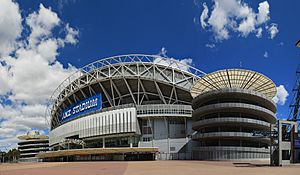
In their first season, Canterbury-Bankstown played few home games. When they did, they used either Marrickville or Pratten Park. From the next season, they started playing most of their games at Belmore Sports Ground. The club had a strong connection with Belmore and stayed there until 1994.
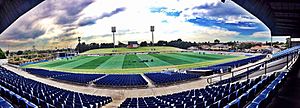
In 1995, during the "Super League War," the club changed its name to "Sydney Bulldogs." They moved games to Parramatta Stadium because it had better facilities for fans. This move was successful, and they won the championship that season. However, the club changed its name back to Canterbury in 1996 and returned to Belmore Sports Ground until the first National Rugby League season in 1998.
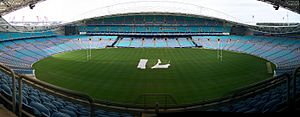
When the new Stadium Australia was built for the Sydney 2000 Olympic Games, the club started playing games there from 1999 to 2000. From 2001 to 2005, they played at the Sydney Showground at Homebush Bay. Bigger matches were still played at Stadium Australia from 2003. Fans complained about the Showground not being a good rugby league ground. So, the club decided to move all future home games to Stadium Australia, where they still play today.
The club's training and offices were at Belmore Sports Ground until 2008, when they moved to Sydney Olympic Park. After a $9 million upgrade, the club's administration and training facilities have now returned to the historic Belmore Sports Ground.
In 2015, the club played two home games at Belmore Sports Ground to celebrate their 80th anniversary. They have continued to play some games at Belmore every year since then. From 2019, they usually schedule only one home game at Belmore. No game was held at Belmore in the 2020 season due to the pandemic.
Supporters
The Bulldogs Army is the main supporter group for the Bulldogs. Their section at games is called 'The Kennel'. To sit here, supporters must be club members and register any large flags or banners. At away games, the Bulldogs Army sits in the general admission area. Their main goal is to show strong support for Canterbury.
The Bulldogs' main fan base is in the Canterbury and Bankstown areas of south-western Sydney. However, in recent years, the club's offices and home games have moved to Sydney Olympic Park. The Bulldogs are also very popular in regional New South Wales. Over 25% of their fans are from regional NSW, and over 25% are from outside NSW. At one point, they had one of the highest average attendances in the league, with over 20,000 fans per home game in 2010. By the end of the 2023 NRL season, their average home attendance was 16,243. At the end of the 2023 NRL season, the club had 22,000 members. This was more than most Sydney clubs, but less than South Sydney and Parramatta.
Many people from different backgrounds live in the club's support areas, like Lakemba. This means the club has many fans from non-Anglo backgrounds. The club is especially known for its connection with the Lebanese and Greek communities. This is partly thanks to former star player Hazem El Masri, who moved from Lebanon as a child. The Greek community has a long history with the club, dating back to the 1970s with club legend Dr George Peponis, who moved from Greece as a child and captained both the Bulldogs and Australia. El Masri retired at the end of the 2009 season.
Famous Bulldogs Supporters
| Famous Bulldogs Supporters | |
|---|---|
|
|
Team Rivalries
Parramatta Eels
The rivalry between the Canterbury-Bankstown Bulldogs and the Parramatta Eels is one of the most intense in the NRL. The two clubs have always been geographically close. In the 1980s, both Canterbury and Parramatta won four championships each. They met in two Grand Finals, in 1984 and 1986.
In the 1990s, during the Super League war, Parramatta signed four of Canterbury's star players. This helped Parramatta reach the finals for the first time in eleven years. In the 1998 preliminary final, Parramatta was winning against Canterbury 18–2 with less than ten minutes left. But Canterbury made one of the biggest finals comebacks, winning 32–20 in extra time.
In the 2007 NRL season, the clubs played each other in an elimination final. Parramatta got revenge for the 1998 preliminary final by beating Canterbury 25–6.
In the 2009 NRL season, Parramatta defeated Canterbury in the preliminary final. This was part of Parramatta's amazing run to the Grand Final. The game had a huge crowd of 74,000 fans, a record for a non-Grand Final match.
Former Canterbury player Craig Polla-Mounter said in 2007 that the fans of both clubs can be very unforgiving when they play each other. He believed it was the biggest rivalry in rugby league. James Graham, a former Canterbury player, said in 2015 that as soon as he joined the club, he was told that Parramatta was their closest rival and there was no love lost between them. Andrew Ryan, who played for both clubs, said both teams emphasize the rivalry before their games.
Sydney Roosters
The Canterbury-Bankstown Bulldogs have a long-standing rivalry with the Sydney Roosters. The two teams have met in Grand Finals four times. In 1938, Canterbury-Bankstown won their first championship against Eastern Suburbs (as the Roosters were then known), winning 19–6. Two years later in 1940, Easts won the 1940 NSWRFL Grand Final 24–14. In 1980, the Canterbury-Bankstown Bulldogs ended a 38-year championship drought by defeating the Eastern Suburbs Roosters 18–4.
In 2002, the Sydney Roosters won the NRL championship after a 9-game winning streak. This was the same year Canterbury lost 37 points due to salary cap breaches. In 2003, the Roosters proved their strength by defeating Canterbury in the preliminary final 28–18. In 2004, the Roosters beat Canterbury 35–0, and fights broke out among fans. While the Roosters finished the regular season as minor premiers, Canterbury defeated them in the Grand Final 16–13, coming back from 13–6 down at half time.
The last time the two clubs met in a finals game was the 2015 Elimination Final, which the Roosters won 38–12.
St. George Illawarra Dragons
The Canterbury-Bankstown Bulldogs have a strong rivalry with their neighbors, the St. George Illawarra Dragons. Canterbury-Bankstown was founded in 1935, 14 years after St. George Dragons. St. George beat Canterbury by a record 91–6 in 1935. However, Canterbury won their first championship in 1938, and St. George won theirs in 1942. In the 1942 NSWRFL season, the two clubs met in the Grand Final, with Canterbury-Bankstown winning 11–9. After that, St. George won eleven championships in a row from 1955–1966. It was Canterbury who ended their winning streak in 1967, beating them by one point in the preliminary final. Since then, both clubs have beaten each other in championships. St. George Dragons defeated Canterbury-Bankstown in their last Grand Final win in 1979, and the Bulldogs returned the favor in 1985.
The two teams met in the 1993 preliminary final, where St. George won 27–12. They met again in the 1995 and 1998 finals series, with Canterbury winning both times. The elimination final in 1998 was St. George's last game as a single club, as they joined with Illawarra for the 1999 NRL season. Canterbury's biggest loss ever was 91–6 against St. George on May 11, 1935.
South Sydney Rabbitohs
Souths and Canterbury-Bankstown have played each other every Good Friday since 2012. They met in the 1967 NSWRFL Grand Final, with South Sydney winning 12–10. Their rivalry became more intense when they met in the 2014 NRL Grand Final, where Souths won 30–6 to claim their first championship since 1971.
Their Good Friday game in 2015 was called "Bad Friday" due to controversy. South Sydney won 18–17 with a late penalty goal. Canterbury fans were very angry and threw bottles at the match officials as they left the field. Some fans received lifetime bans for this.
In Round 4 of the 2021 NRL season, Canterbury lost 38–0 to South Sydney in the traditional Good Friday game. This made Canterbury only the second team in the NRL era to lose three straight games without scoring a point. It was also the worst start to a season for any team since 1928. In Round 6 of the 2023 NRL season, South Sydney scored the most points ever by a winning team in a Good Friday game, defeating Canterbury 50–16.
Canterbury League Club
The Canterbury League Club is the official club for the Canterbury-Bankstown Bulldogs. It opened in September 1956 to support the football club and the local community. Its first location was a Salvation Army Hall.
Within two years, the club grew quickly. In 1960, it moved to Bridge Street, allowing it to expand and provide parking for visitors.
In 2000, the Board approved major renovations. These started in 2000, and by 2002, new areas like the Brasserie, Restaurant, foyer, and health club were open to the public.
The club also joined with Lakemba Services Memorial Club (2008) and Belfield RSL (2013).
Canterbury League Club has many facilities, including three restaurants, two coffee shops, several bars, entertainment lounges, and a 24-hour health club.
Team Statistics and Records
Hazem El Masri holds the NRL record for the most games played for the club, with 317 appearances.
Hazem El Masri also holds records for the most points scored (2,418) and the most tries scored (159) for the Bulldogs. His point total was a competition record for Australian Rugby League until 2019. Former player Daryl Halligan previously held the competition record with 2,034 points, including points from his time at the North Sydney Bears.
The club's largest win was in 1995, when they were the "Sydney Bulldogs." They beat the North Queensland Cowboys 66–4. In their first season in 1935, they suffered their two heaviest defeats in competition history in back-to-back weeks. They lost to St. George 91–6 and then to Eastern Suburbs 87–7. However, despite these big losses, the club won their first championship three years later in 1938. This made them the fastest non-founding club to win a title, a record that stood until 1999.
In 2002, the club won 17 matches in a row after losing to the New Zealand Warriors. They were just two wins short of the record set by the Eastern Suburbs team in 1975.
In Round 7 of the 2014 season, after beating the South Sydney Rabbitohs 15–14, Canterbury became the first club to win three consecutive matches by one point. They later finished as runners-up to South Sydney in the Grand Final.
Canterbury is the only team in NSWRL/NRL history to win a championship and then finish with back-to-back wooden spoons. In 1942, they won their second championship but then finished last in 1943 and 1944. Canterbury also had one of the longest championship droughts, not winning a title between 1942 and 1980, which was 38 years.
Players
2025 Squad
Hall of Fame
On August 1, 2015, the Canterbury-Bankstown Bulldogs announced the first five players to be inducted into their Hall of Fame. This was part of their 80th-anniversary celebrations. Three more former players were inducted in February 2025 during the club's 90th-anniversary celebrations.
| Player # | Inductee | Active | Achievements | Games played |
|---|---|---|---|---|
| 16 | Eddie Burns | 1935–1950 | 2× Premiership winner (1938, 1942)
Coach: 1960–62, 1965 |
215 |
| 284 | Les Johns | 1963–1971 | National Rugby League Hall of Fame inductee | 103 |
| 402 | George Peponis | 1974–1982 | 1× Premiership winner (1980) | 132 |
| 413 | Steve Mortimer | 1976–88 | 4× Premiership winner (1980, 1984, 1985, 1988)
National Rugby League Hall of Fame inductee |
273 |
| 477 | Terry Lamb | 1984–1996 | 3× Premiership winner (1984, 1988, 1995)
National Rugby League Hall of Fame inductee |
262 |
| 303 | Johnny Greaves | 1964–1972 | 112 | |
| 432 | Steve Folkes | 1978–1991 | 4× Premiership winner (1980, 1984, 1985, 1988)
Coach: 1998–2008 1× Premiership coach (2004) |
245 |
| 605 | Hazem El Masri | 1996–2009 | 1× Premiership winner (2004)
Club highest point scorer (2,418) Club highest try scorer (159) |
317 |
Notable Players
On August 1, 2015, the Canterbury-Bankstown Bulldogs announced a "Team of the Decade" to celebrate their 80th anniversary.
| First team squad | Interchange | Coaching staff | |||||||
|---|---|---|---|---|---|---|---|---|---|
|
|
Updated: 1 August 2015 |
|||||||
Club Honours
- New South Wales Rugby League, Australian Rugby League and National Rugby League Premiers: 8
-
- 1938, 1942, 1980, 1984, 1985, 1988, 1995, 2004
- New South Wales Rugby League, Australian Rugby League and National Rugby League Runners-up: 10
-
- 1940, 1947, 1967, 1974, 1979, 1986, 1994, 1998, 2012, 2014
- New South Wales Rugby League, Australian Rugby League and National Rugby League Minor Premierships: 7
-
- 1938, 1942, 1947, 1984, 1993, 1994, 2012
Reserve/Pre-season Representative Honours
- New South Wales Rugby League Club Championships: 7
-
- 1938, 1939, 1993, 1994, 2009, 2010, 2011
- Pre-Season Cup Titles: 2
-
- 1962, 1970
- Inter-City Titles: 1
-
- 1939
- NRL State Championship: 1
-
- 2018
Junior Representative Honours:
- Jersey Flegg Premiers: 10
1963, 1971, 1976, 1979, 1983, 1999, 2000, 2001, 2003, 2023
(Record - Most Jersey Flegg Titles)
- SG Ball Premiers: 3
1972, 1978, 2009
- Harold Matthews Premiers: 4
2007, 2009, 2011, 2023
NRL Women's Team
 |
|||
| Club information | |||
|---|---|---|---|
| Full name | Canterbury-Bankstown Bulldogs Rugby League Club | ||
| Nickname(s) | Dogs, Doggies, The Family Club | ||
| Website | bulldogs.com.au | ||
| Colours | Blue White |
||
| Founded | Team: 28 Mar 2024 Club: 1935 |
||
| Current details | |||
| Ground(s) |
|
||
| CEO | Aaron Warburton | ||
| Chairman | Adam Driussi | ||
| Coach | Brayden Wiliame | ||
| Manager | Phil Gould | ||
| Captain | Tayla Preston Angelina Teakaraanga-Katoa |
||
| Competition | NRL Women's Premiership | ||
| Uniforms | |||
|
|||
On March 28, 2024, the NRL announced that the Bulldogs were one of two clubs allowed to join the NRL Women's Premiership starting in the 2025 season. The club then announced Blake Cavallaro as their first NRLW coach. In July 2024, they signed their first players. Cavallaro resigned in January 2025.
On April 7, 2025, Brayden Wiliame was announced as the head coach for the club's first NRLW season.
The first 24-player NRLW squad, along with 4 development players, was announced on May 12, 2025.
The first squad includes:
- Alexis Tauaneai
- Andie Robinson
- Angelina Teakaraanga-Katoa
- Anneka Wilson
- Ashleigh Quinlan
- Bridget Hoy
- Ebony Prior
- Elizabeth MacGregor
- Holli Wheeler
- Hope Millard
- Kalosipani Hopoate
- Latisha Smythe
- Maatuleio Fotu-Moala
- Moana Courtenay
- Monica Tagoai
- Paea Uilou
- Pauline Suli-Ruka
- Sarahcen Oliver
- Shaniece Monschau
- Shannon Muru
- Shaquaylah Mahakitau-Monschau
- Tayla Preston
- Tegan Dymock
- Vani Buleki
NRLW Development Contracted Players:
- Lahnayah Mahakitau-Monschau
- Leilani Wilson
- Simina Lokotui
- Waimarie Martin
Other Women's Teams
The club also has women's teams in development competitions run by the New South Wales Rugby League. These include the open-age Harvey Norman Women's Premiership, the Under 19 Tarsha Gale Cup, and the Under 17 Lisa Fiaola Cup.
Canterbury-Bankstown Junior Clubs
Current Canterbury-Bankstown junior clubs are:
In 1908 and 1909, only the South Sydney and Balmain areas had Junior Rugby League teams. The first clubs from the Canterbury area to play rugby league were Belmore and Campsie Triers. When the St George Junior Rugby League started in 1911, Canterbury clubs joined that competition. In 1922, the Canterbury Junior Rugby League was formed. Campsie Iona won the A Grade title in 1922, 1923, 1924, and 1925 before Belmore won in 1926.
See also
 In Spanish: Canterbury-Bankstown Bulldogs para niños
In Spanish: Canterbury-Bankstown Bulldogs para niños


